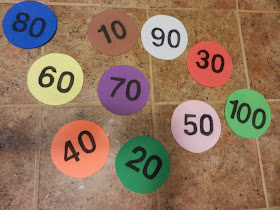Easter
Fun with numbers!
Here is a fun game for reinforcing numbers with your
kids. I use this for my Spanish class
with children 4 and 5 years. These games can also be use for reinforcing numbers and colors in any language.
 |
| These colorful eggs are great for reinforcing colors and numbers! |
 |
| Cute chicks with numbers to use with egg games. |
Game 1:
Place the numbers inside each egg. Hide the eggs in different
locations in the room. Have students look for the eggs then open it and say the
number they found in Spanish.
Game 2:
Place numbers inside the eggs. Have students find a particular
number (for example 15). The student that finds the number 15 say: “encontré
quince” (I found fifteen)
Game 3:
This game reinforces numbers and colors at the same time. Place numbers inside the eggs.
Place eggs in a basket or plate. Have students sit in a circle with the basket of eggs in the middle. Select a student and give a command in Spanish: “abre el huevo azul” (open the blue egg) Student finds and opens the blue egg. Then ask: “¿qué número es? Student should say the number in Spanish.
Place eggs in a basket or plate. Have students sit in a circle with the basket of eggs in the middle. Select a student and give a command in Spanish: “abre el huevo azul” (open the blue egg) Student finds and opens the blue egg. Then ask: “¿qué número es? Student should say the number in Spanish.
Game 4:
Give each student an egg with a number inside. Have student
stand in a circle while holding the egg.
Go around the circle saying in Spanish this little chant:
“Estoy buscando el número
diez, número diez, número diez.
"Estoy buscando el número diez. ¿tienes
tú el número diez? (look at a student and ask the question) Student
opens the egg to see if he/she has the number ten. If student does not have the
number ten, student say: “no tengo el número diez” Continue in the circle until
you find the student with the number.
If student have the number
ten student say: “si, tengo el número diez”.
Then
the student with the number comes out the circle. Repeat the same until all
student had the opportunity to discover their number.
Game 5:
Place number in eggs but leave one egg empty. The amount of
eggs should be the same as the amount of students participating. So if there are 10 children participating in the game there should be 10 eggs (nine eggs with
number and one without) Students should not know which egg is empty. Each
student picks an egg out the basket.
These “Eggy” number cards are excellent for reviewing the
numbers!
You can download these cards, the cute chick number cards and the regular number cards here for free! Included are blank cards too so you can select and use your own numbers!
You can download these cards, the cute chick number cards and the regular number cards here for free! Included are blank cards too so you can select and use your own numbers!
Have fun!
Follow me on TpT by clicking on the green star right under my
store name “Music and Spanish Fun”: https://www.teacherspayteachers.com/Store/Music-And-Spanish-Fun









.jpg)











